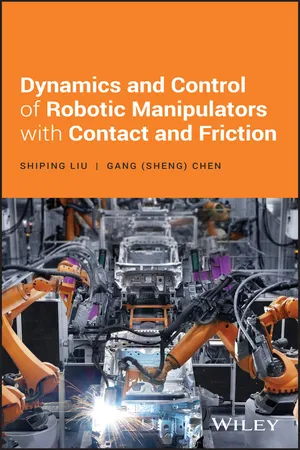1.1 Robot Joint Friction Modeling and Parameter Identification
Robot design generally considers only the ideal circumstances. The actual robot experiences great differences from the model built and simulated with MATLAB or other graphical tools, with manufacturing errors, friction, and gravity contributing the most to these differences [1]. There are also complex nonlinear problems [2]. With the wide application of robots in different industries involving humans, the demands of safety, accuracy, and reliability on robots is continually increasing. Contact and friction always influence the accuracy and reliability of the robot. For a more reliable and accurate solid robot, the design – especially control design – must account for friction, contact, and impact, as well as friction in the force feedback mechanism.
In recent decades, industries and academia have conducted research and developed related to robotic dynamics and control. In recent years, some have focused on the contact and friction generated in robot joints during movement [3–8]. There have been different methods presented to build an accurate model of joint friction based on experimentation and analysis of the corresponding results. Nonlinear characteristics of friction [9–15] are obvious, especially in the low‐speed motion of robot, so nonlinear dynamics of robot must be considered as well.
Friction is a tangential resistant force to sliding in a dynamic system. To investigate friction, it is necessary to characterize the surface roughness in terms of its statistical properties. Friction has been demonstrated to be related to surface topography, and friction investigation has been conventionally attributed to the determination of the actual area of contact and understanding the contact mechanism. For instance, surface physics explains friction as the formation of adhesion between interacting asperities and their breakaway by shearing, whereas continuum mechanics interprets friction by interlocking and subsequent fracture of asperities.
To address the problem of actual sliding asperity contact is quite difficult, which involves complex dynamics. The feasible approach is to assume the contact to be quasi‐static in nature, to certain extent. In many applications with relatively smooth surfaces, the deformation of contacting asperities can be assumed to be linear and elastic. For many problems the contact has to be extended to non‐elastic and nonlinear conditions and involve dynamics.
1.2 Contact Perception in Virtual Environment
Research on robot dynamics and control with consideration of contact and friction is a major topic of this book. Contact perception, which is part of the interaction between a human and a real or virtual robot, is also discussed. In a virtual environment, force feedback or surface texture generally needs to be calculated according to dynamics with friction and contact.
Contact perception is generally achieved by different types of haptic devices [16–22]. The force signals or the surface texture signals, coming from the real measurement or calculation, is input into the haptic device so the operator gets the expected contact feeling. The real measurement is carried out when the real robot works in the real environment. In virtual simulation, the virtual interaction force between the virtual robot and the virtual environment needs to be calculated in real time according to relevant contact or friction models. The measured or calculated force signals are filtered and sometimes transformed according to a certain scale.
Virtual reality and mixed reality are widely used in robot control, especially for control simulation [23–31]. The purpose of the virtual simulation in some instances is to verify the underlying robot control algorithm, while others are to provide graphical modes to assist the operator with real‐time robot control, reducing manual error. This book mainly discusses the related research of virtual reality or augmented reality teleoperation [30–37]. Interactive task planning with graphical assistance is also explored.
1.3 Organization of This Book
Chapter 1 introduces the book and major topics are stated.
Chapter 2 introduces the fundamentals of robot dynamics and control. Besides the typical kinematics and dynamics of a robot with six degrees of freedom (6 DoF) or less, the kinematic reverse solution of a 7 DoF robot is also introduced. In this chapter, different robot control modes are classified as either trajectory control or interaction control, and reviewed.
In Chapter 3, theories and methods in contact and friction are reviewed according to the classification of wet friction and dry friction. In this chapter, we present the fundamentals of contact and friction between two contact surfaces in the context of quasi‐static state by assuming that the normal motion is ignored. We focus on the mechanics of contact and friction by outlining the mechanical attributes of various friction processes in the context of the problems of the friction‐vibration interactions.
Chapter 4 introduces friction modeling and parameter identification of robot joints. The dynamic parameter identification methods of multiple‐joint robot systems are also introduced. This chapter uses the two‐link planar robotic arm as the experimental object to verify theories and methods discussed in previous chapters. Nonlinear dynamics and chaos are also discussed in this chapter.
The operator of a remote or virtual robot can feel the contact between the robot and its real or virtual working environment via a haptic device. In Chapter 5, principles of several common haptic devices with force feedback are analyzed. The calculation of virtual force caused by contact in a virtual environment is discussed. Haptic display based on point haptic devices is also reviewed.
Chapter 6 introduces virtual simulation of robot control and 3D graphic environment, virtual reality–based robot control and augmented reality–based teleoperation are reviewed. Task planning based on graphical mode is also discussed.
References
- 1 Japan Robot Association (2008). The New Handbook of Robot Technology Zong G.H., Cheng J.S., trans., 2e, 244–245. Beijing: Science...
